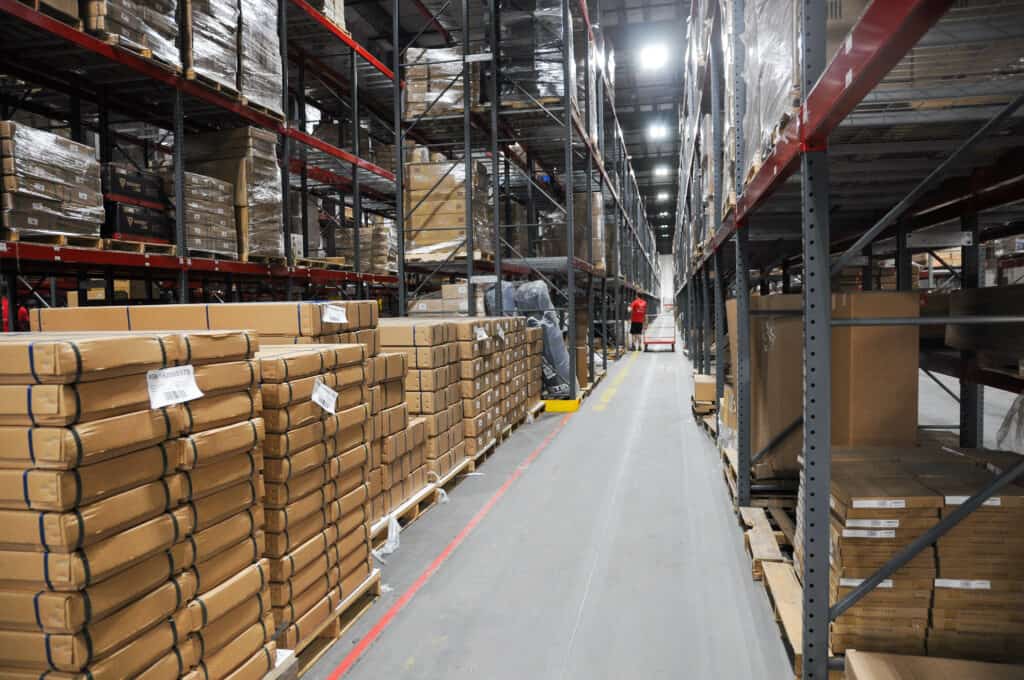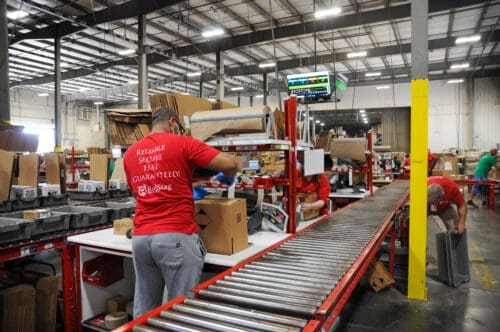Few things are as frightening as having way too much inventory on hand if you’re an eCommerce company. That forces you to consider selling goods cheaply, scrapping some inventory, or moving that extra stock to a surplus warehouse as you hope to reduce storage costs.

A surplus warehouse isn’t just a place for extra furniture or old Army gear. It’s also a place for businesses to store products in large quantities, usually in pallets or crates, as you try and figure out what to do with them. Bulk storage can be useful, but it may also make it harder to have an accurate inventory count, which puts your business at risk.
So, let’s take a more in-depth look at surplus warehouses, surplus storage, and what you can do to avoid these options or maximize their use.
What do surplus warehouse and surplus storage mean?
If you Google terms like “surplus storage” and “surplus warehouse,” you’re likely taken to websites and news articles all about businesses that offer “big deals” on name brand products or those that offer surplus military equipment and ammunition. Unfortunately, good old Google can kind of muddy the waters because what you’re likely after is a place to store your extra inventory.
Surplus storage, in broad terms, is storage for excess goods that you can’t move right now. You might need space to hold things that aren’t selling, or your manufacturer has increased minimum order volumes, so you needed to buy in bulk but don’t have the room to hold it all in your existing facility. Some companies also buy extra inventory and need surplus storage when their imported goods take time to get through customs.
Having surplus storage available makes it easier to buy large quantities (hopefully at a discount from your manufacturer) and have inventory to meet orders when part of your supply chain or customer base is uncertain.
A surplus warehouse is simply a warehouse you own or lease or access via a third party like Red Stag Fulfillment, where you can store this extra inventory. In many cases, you’re shipping at freight volumes to and from these warehouses. That’s great because it allows you to save money on your shipments by accessing more carrier options. If you’re using inventory management and demand planning techniques, you can move inventory from a surplus warehouse to your traditional fulfillment warehouse regularly enough to avoid any expedited costs.
How do I find a surplus warehouse?
The best way for you to find surplus warehouses in your location — and ones that meet your specific needs, such as cold storage — is to contact 3PLs and warehouse service providers in your region or where you want to store goods. Ask for recommendations and if they have any advice on how to evaluate these partners.

If you want to search for yourself first, start with warehouses and fulfillment providers with facilities that can service your product niche. For example, Red Stag Fulfillment has expertise in storing and fulfilling high-value, heavy, and bulky products for eCommerce businesses. If you need to find a surplus warehouse, we’re happy to be a resource, no matter what your product category.
Look for a company that knows your industry and its requirements. Ask about the suppliers and warehouses they’ve worked with throughout the past. Explain that you’re looking for someone who handles these bulk surplus shipments and has appropriate pricing. Explain if you expect there to be less warehouse labor than in a standard center, such as your partner being able to accept pallets and then ship pallets to you.
How do I handle surplus stock challenges?
The downside to using a surplus warehouse is that you’ve got a decent amount of capital tied up in inventory. If the economy struggles or you face a downturn similar to COVID-19, you run the risk of not being able to move inventory and having that excess stock simply continue to burn cash. And, you’re probably not like Nike or Urban Outfitters, who can afford to literally set fire to millions of dollars’ worth of inventory each year.
If you’re currently facing the need to expand to a surplus warehouse or have the extra inventory you can’t move, there are a few tactics to employ:
- Start by evaluating your capital and revenue. See how long you can afford to store your current stock and if it might be cheaper to shift some existing inventory from a 3PL to a surplus location.
- Negotiate with manufacturing and wholesale partners to reduce your minimum order volume if possible.
- Reach out to potential retail partners. See if you can find someone willing to carry your inventory in their stores. Look at regional as well as national brands and be open to a lower margin than you would have required in 2019.
- Review sales and marketing to see if you can target a new industry or niche experiencing a shortage in a related product category.
- Discount products and scale these discounts up when someone buys more of an SKU.
- Bundle items with kitting services.
- Offer some goods as freebies or incentives.
- Ask your surplus warehouse partners about liquidation companies or if they’ve partnered with donation services where you can free up cash flow and even potentially land a tax deduction.

What are other eCommerce companies doing with excess inventory?
Specifically, in the eCommerce space, companies with excess inventory often turn to surplus warehouses and surplus storage options, then revamp their marketing and sales strategies. You’re not going to have as many opportunities as brands with a brick-and-mortar location, but there’s still plenty for your eCommerce brand to do.
Here are seven things we saw eCommerce brands do in 2020:
- Offer clearance and deep discount sales. Take inventory that hasn’t sold for many months and slash its price to the bone. Eliminate margins or even turn these into loss leaders.
- Offer free shipping and shipping upgrades on all orders or orders of specific values.
- Create personalized emails to offer customers deals on specific products, relying on past purchase data.
- Update websites and sales pages to highlight discounted items. Some have created their first permanent clearance and sales sections.
- Revamp SEO strategies and social advertising, targeting a broader set of keywords and customers.
- Seek out partnerships with related eCommerce companies and those sharing the same warehouses, looking for chances to sell goods together and minimize fulfillment costs.
- Ask current warehouse partners to help with your merchandise. Can they offer you a lower rate if you hold a higher volume? Can they store your goods higher up because they’ll be used less often?
Can eCommerce inventory management help?
Searching for a surplus warehouse usually comes after an eCommerce company realizes they will have too much stock to move or store. If you’re at that point, inventory management practices can’t help you immediately, but they can make it easier to avoid getting into this situation again.
When you improve inventory management, you improve your cash flow and reduce the chance of backorders and stockouts. It requires an understanding of your supply chain, which Red Stag can help you achieve. But when you put its practices in place, there are plenty of opportunities to help you move slow-moving and obsolete inventory out of your operations.

Do I need more or fewer locations?
One potential option for eCommerce companies to tackle surplus inventory involves adjusting their strategy. Instead of looking for surplus warehouses, consider working with partners that offer multiple warehouse locations. There are a few benefits to having more than one warehouse send out your goods.
If you did some Googling and reading before arriving at this blog, the E. C. Barton company was likely mentioned because their store’s name is Surplus Warehouse. The outlet company has been expanding for years and continued to push its new store locations even during the economic downturn. The difference is that new stores prioritize large cities and regionally central locations that could make it easy to reach a broad audience. They moved closer to larger customer pools and major road systems to make it easier to get goods in and out of their locations.
For your eCommerce company, you want warehouses that take the same approach. Having inventory in multiple locations near large population centers and having access to broad transportation networks can reduce many of your costs. Shipping from locations closer to your customers means it costs less, and major distribution centers often have access to freight and rail movements that can reduce your inbound shipping costs.
It all starts with your sales data
Knowing where to begin is tough, but the best place is usually within your order and inventory management systems. These tools help you understand customers and what demand was and inventory levels compared to historical sales. You can start predicting what you’ll need for the year and how to utilize or move it best.
Reviewing your inventory and average order may help you decide to put some stock into a surplus warehouse. Or you might avoid having surplus inventory by pushing sales options that your customers responded to previously. Look for what’s working in the past and how your industry at large is performing. Generally, there are multiple options for you to manage and utilize your inventory to continue to generate revenue.











